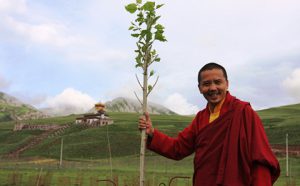In September, an unusual environmental organisation was launched in one of the most ancient and significant sites in China – the Songyang Academy, Dengfeng, Henan. Founded in the 11th century AD, this was one of the four Confucian Academies of China. The site was originally Buddhist; it became Daoist in the early 7th century and Confucian in 1035.
All of that is but a footnote in history compared with the two ancient pine trees on the site, which were already so venerated in 110 BC that Emperor Wu of the Han Dynasty went there to worship them.
It was in the presence of these two great ancient trees that the International Confucian Ecological Alliance (ICEA) was inaugurated. It marked the first time a specific Confucian organisational response has emerged to the environmental issues confronting not just China, but (as ICEA’s title says) the whole world.
The Confucianists are planning to designate two cities as models of Confucian ecological values: Confucius’s birthplace of Qufu in Shandong, and Dengfeng in Henan. Both commitments are part of their membership of the Green Pilgrimage Network (GPN), which links pilgrim places around the world in their journey to become greener.
Later this year they will start work on developing an eight-year plan of environmental action based around their 500 temples and dozens of academies.
They also plan, in association with the Ministry of Education, to sponsor 100 lecture events on Confucianism and ecology, and establish an academic board to oversee scholarly research on Confucian values and ecology. Next year they will celebrate the 2,565th birthday of Confucius with a huge gathering in Beijing focusing on ecology.
Meanwhile, earlier this month, at Asia House in London, the China Daoist Association announced the further development of their 20 years of action on ecology. President of the Association, Master Ren Farong, spoke powerfully about his faith’s protection of sacred mountains; its involvement in developing Green Pilgrimage in China and commitment to stop the illegal wildlife trade, through restoring Traditional Chinese Medicine (TCM) to its proper, herbal foundations.
All this shows that the desire to find ways of being and living which reflect deep Chinese cultural traditions, wisdom and insights is now a considerable movement not just amongst young Chinese but across all age groups. Daoism and Confucianism, as the two indigenous spiritual and philosophical traditions of China, are at the very core of the recovery of a specifically Chinese perspective on protecting our planet.
When they created their first statement on Daoism and the environment 20 years ago, the Daoists traced four principles.
1. Follow the Earth
The Earth respects Heaven, Heaven abides by the Dao, and the Dao follows the natural course of everything. Humans should help everything grow according to its own way. We should cultivate the way of no-action and let nature be itself.
In a survey of the nine major sacred mountains of China (five Daoist ones: four Buddhist) in the late 1990s it was found that where religious communities had managed to return to the sacred mountains after the Cultural Revolution, they had helped to protect a far wider range of biodiversity than on any comparable mountains. From this has come a programme of Daoist temples identifying indigenous and threatened species and creating nurseries to sustain their recovery.
2. Harmony with nature
In Daoism, everything is composed of two opposite forces known as Yin and Yang. The two forces are in constant struggle within everything. When they reach harmony, the energy of life is created. Someone who understands this point will not exploit nature, but will treat it well and learn from it.
This is the philosophical, spiritual and physiological basis of the programme of the Daoists to oppose the use of endangered species – including tigers, elephants and rhinos – in what passes for TCM. Daoists are now teaching that if, by sourcing the ingredients you have disturbed the balance of yin and yang in the world, by harming rare species, or giving pain to other creatures, then the medicine will not work. Indeed it will harm you if you take it.
See also: How much will it cost to save nature?
3. Too much success
If the pursuit of development runs counter to the harmony and balance of nature, even if it is of great immediate interest and profit, people should restrain themselves from it. Insatiable human desire will lead to the over-exploitation of natural resources. To be too successful is to be on the path to defeat.
The critique of consumerism runs deep within the Daoist ecological programme and at one level is symbolised by the Three Sticks Movement. Temples noticed that with increased wealth people were bringing huge bunches of incense sticks to burn at the shrines as if they could influence the gods by their excess. So the Daoists brought in a rule of simplicity. Just three sticks of incense is enough, one for Heaven, one for Earth and one for yourself. In one small message is a big idea on how to live sustainably.
4. Affluence in bio-diversity
Daoism has a unique sense of value in that it judges affluence by the number of different species. If all things in the universe grow well, then a society is a community of affluence. If not, this kingdom is on the decline. This view encourages both government and people to take good care of nature.
So often the environmental movement is about instilling a sense of guilt and even fear. It doesn’t work. This is why Daoism encourages a positive view of the natural richness of nature as a cause for celebration. At Louguantai in Shaanxi where Lao Zi wrote the core Daoist book, the Dao De Jing, the temple has become the major centre of Daoist ecology. It runs monthly ceremonies to celebrate the cycle of nature. These attract thousands of people from the nearby city of Xi’an, who want to be put back in touch with the rhythm of nature.
Confucianism is new to this but its first ever Statement on the Environment in 2013 shows where it is going to put its energy over the next few years: into “a sustainable harmonious relationship between humans and nature”.
As the Shang Shu, one of the Five Confucian Classics, says so pithily in Chapter 22: “Just do what is right and proper and then all will be well.”






![Up to one million Amur falcons are concentrated in Nagaland on their migration route to southern Africa. Doyang reservoir, Nagaland [image by: BIOSPHOTO / Alamy Stock Photo]](https://dialogue.earth/content/uploads/2013/11/JR2TMB-300x200.jpg)